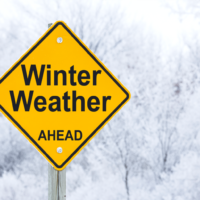
With snow and below-freezing temperatures expected for much of Oregon, AAA Oregon/Idaho urges drivers to be prepared for winter driving conditions. Winter weather’s expected just as thousands of holiday travelers hit the roads.
The National Weather Service in Portland says the forecast looks increasingly wintry for even lower elevations of northwest Oregon as a prolonged period of below normal temperatures begins this weekend. “Make sure your vehicle is ready for cold weather, and that you’re prepared to drive on slick roads and with reduced visibility,” says AAA Oregon/Idaho Public Affairs Director Marie Dodds. Find tips and helpful advice at AAA.com/winterprep.
Whenever Mother Nature brings snow and freezing temperatures, the number of calls to AAA Oregon/Idaho for roadside assistance can spike. The most common problems in cold weather are dead batteries, frozen locks and vehicle extrications. “Drivers aren’t always prepared to deal with colder weather and winter driving conditions,” adds Dodds.
Before heading out in Oregon, check the latest forecasts, and visit TripCheck.com or call 511 for the latest road conditions and incident information, especially if you are driving over mountain passes.
Here are the top four tips for cold weather prep:
- Check your vehicle’s battery. Dead batteries are the number one reason why people call AAA during a cold snap. “Most vehicle batteries have a lifespan of about three years. If your battery is approaching the end of its lifespan, it may turn over fine when it’s 40 degrees and raining, but it may not start up when the thermometer dips below freezing, especially if the cold weather lasts for longer than a couple of days,” says Dodds.
- Have proper traction. Equip your car with the right snow tires, or carry chains or tire socks and know how to put them on.
- Know how to go on ice and snow. The number one mistake people make when driving on slick roads is going too fast for the road conditions.
- Don’t leave home without an emergency kit in your car. Bring water and snacks for all passengers. Even a normally short trip can take hours in wintry weather so have enough provisions in case of a long delay.
Below are more tips on preparing your vehicle, what to put in your emergency road kit, and how to drive on ice and snow from AAA Oregon/Idaho.
Car Preparation:
- Make sure your vehicle has proper traction. Snow tires and/or chains are often the best options in snowy conditions. Carry chains or tire socks and know how to put them on. With light or moderate snowfall, a set of all-season tires may suffice. Remember the amount of traction that exists between the tires and roadway surface determine how well your vehicle accelerates, turns and stops.
- All-wheel-drive and four-wheel-drive systems can improve traction in many situations; however, they don’t provide significantly greater traction on ice.
- Have your battery and electrical system tested. Most batteries have a life span of about three years and may not turn over in cold weather. AAA can check your battery before you hit the road. Schedule a time for a AAA battery technician to come to your vehicle and test your battery, starter and alternator. We’ll even deliver a new battery, install it and take away your old one. Visit AAA.com/battery.
- Check all fluid levels, including anti-freeze, transmission fluid, brake fluid and engine oil.
- Make sure all lights operate properly.
- Inspect tires and brakes. Tires with less than 4/32” of tread will have reduced traction in wet and snowy conditions. Put a quarter in the tread. If you can see the top of George Washington’s head, it’s time to start thinking about replacing the tire. In addition, make sure tires are properly inflated, and check for signs of uneven wear.
- Check windshield wipers and washer fluid levels.
- Keep the fuel tank at least half full and make sure your electric vehicle has enough range in case you get stuck or encounter long traffic delays.















